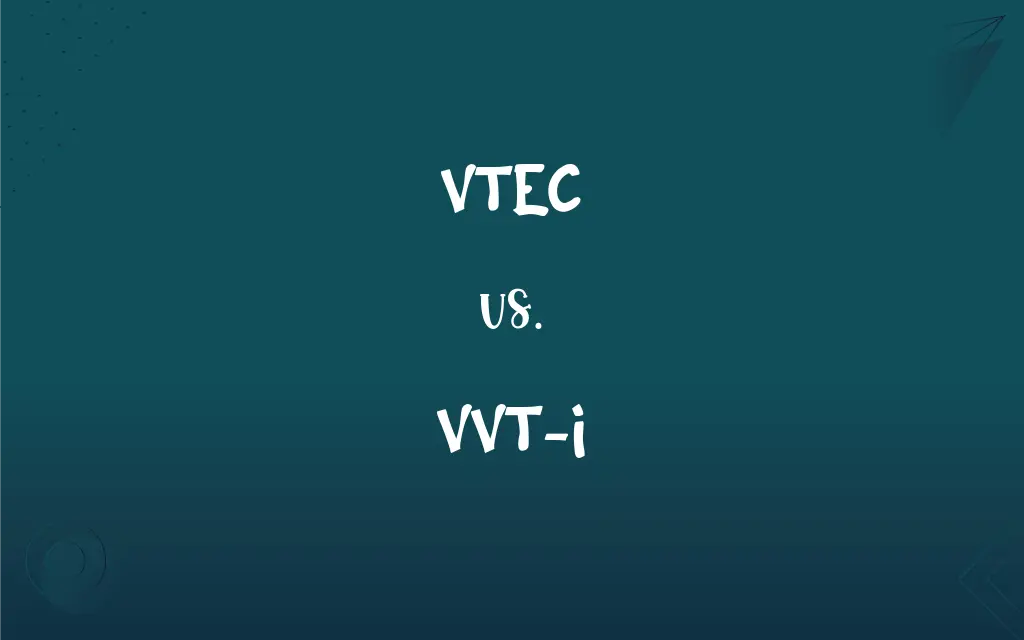VTEC vs. VVT-i: What's the Difference?
Edited by Aimie Carlson || By Janet White || Published on March 14, 2024
VTEC (Variable Valve Timing and Lift Electronic Control) optimizes engine performance and efficiency by altering valve timing and lift, while VVT-i (Variable Valve Timing with intelligence) adjusts valve timing for enhanced power and economy.

Key Differences
VTEC, developed by Honda, revolutionizes engine performance by adjusting the valve lift and timing as the engine speed changes, offering both efficiency at low RPM and performance at high RPM. VVT-i, Toyota's innovation, focuses on optimizing valve timing to improve performance, fuel economy, and emissions across a broader range of engine speeds. Both technologies signify a leap in internal combustion engine design, yet they approach the task with different mechanisms and priorities.
VTEC technology is renowned for its ability to dramatically change the engine's character, allowing for both fuel-efficient cruising and high-performance output when needed, while VVT-i aims for a more consistent improvement in performance and efficiency. This difference illustrates the distinct engineering philosophies behind each brand’s approach to enhancing engine capability and efficiency.
VTEC systems are particularly noted for the noticeable "kick" at the higher RPM range when the system switches cam profiles for increased air flow, a feature that has become synonymous with Honda's performance cars. In contrast, VVT-i's adjustments are more subtle and continuous, aiming to provide a smooth acceleration curve without the abrupt power delivery associated with VTEC.
The implementation of VTEC often requires more complex mechanical components, such as multiple cam profiles and an electronic control system to switch between them. Conversely, VVT-i maintains simplicity by primarily adjusting the timing of the existing camshaft, relying on hydraulic pressure and sophisticated control algorithms.
Despite their differences, both VTEC and VVT-i share the goal of enhancing the engine's adaptability to varying driving conditions, optimizing performance and efficiency. They embody the evolving landscape of automotive technology, where intelligent systems redefine the boundaries of engine performance.
ADVERTISEMENT
Comparison Chart
Primary Function
Alters valve timing and lift
Adjusts valve timing only
Performance Impact
High performance at high RPM; noticeable "kick"
Smooth performance across all RPMs
Fuel Efficiency
Improved at low RPM, optimized for performance at high RPM
Consistently improved across RPM ranges
Emission Reduction
Enhanced by precise control over valve operations
Achieved through optimal combustion timing
Complexity
More complex due to mechanical components for lift and timing
Simpler, focusing on timing adjustments
ADVERTISEMENT
VTEC and VVT-i Definitions
VTEC
VTEC is a Honda engine technology optimizing performance through variable valve timing and lift.
The Civic's VTEC engine roared to life, delivering a surge of power on the highway.
VVT-i
VVT-i improves fuel efficiency and power by precisely controlling the timing of valve opening and closing.
With VVT-i, my Corolla achieves impressive fuel economy without sacrificing power.
VTEC
VTEC technology enhances both fuel economy and power output in Honda engines.
The VTEC engine in the CR-V balances fuel efficiency with the power needed for uphill climbs.
VVT-i
VVT-i utilizes intelligent control to optimize valve timing for various speeds and loads.
The VVT-i in my Highlander makes it capable of handling both heavy loads and efficient cruising.
VTEC
VTEC adjusts valves mechanically for efficiency at low speeds and performance at high speeds.
My Accord's VTEC kicked in, and the acceleration boost was immediately noticeable.
VVT-i
VVT-i technology offers enhanced engine responsiveness and reduced emissions.
The VVT-i system in my RAV4 ensures cleaner emissions alongside responsive performance.
VTEC
VTEC systems switch between cam profiles to match engine speed requirements.
The VTEC system in my S2000 ensures a smooth transition from economical cruising to spirited driving.
VVT-i
VVT-i is Toyota's engine technology that optimizes performance by adjusting valve timing.
The Camry's VVT-i engine delivers smooth acceleration from a standstill to highway speeds.
VTEC
VTEC allows for a wider power band by dynamically adjusting valve operation.
Thanks to VTEC, my Prelude performs exceptionally well across a broad RPM range.
VVT-i
VVT-i dynamically adjusts to driving conditions for optimal engine performance.
Thanks to VVT-i, my Avalon adapts seamlessly, whether I'm city driving or cruising on the freeway.
FAQs
How does VVT-i improve engine performance?
VVT-i improves performance by continuously adjusting valve timing to match driving conditions.
What is VTEC?
VTEC is Honda's engine technology enhancing performance by varying valve timing and lift.
What is VVT-i?
VVT-i is Toyota's technology that optimizes engine efficiency and power through adjustable valve timing.
How does VTEC work?
VTEC works by switching between different camshaft profiles to adjust valve operation according to engine speed.
Can VTEC improve fuel efficiency?
Yes, VTEC improves fuel efficiency at low speeds while providing increased power at high speeds.
Which Toyota models use VVT-i?
VVT-i is used across a wide range of Toyota models, from compact cars to SUVs.
Do all Honda cars have VTEC?
Not all, but many Honda models are equipped with VTEC engines, particularly performance and upper-range models.
Is VTEC noticeable when driving?
Yes, drivers can often feel a "kick" as VTEC switches cam profiles for higher performance.
What makes VVT-i different from other variable valve timing systems?
VVT-i's intelligence in adjusting timing for optimal performance and efficiency sets it apart.
Does VTEC require special maintenance?
VTEC engines may require regular maintenance like any engine, but no special additional care.
Is VVT-i technology expensive to repair?
Repairs can vary, but VVT-i systems are generally reliable and not excessively expensive to maintain.
Can VTEC technology be found in non-Honda vehicles?
While VTEC is specific to Honda, similar variable valve timing technologies are used by other manufacturers.
When was VVT-i first used in Toyota vehicles?
Toyota introduced VVT-i in the late 1990s, enhancing their engines' performance and efficiency.
Is VVT-i effective in reducing emissions?
Yes, VVT-i reduces emissions by ensuring optimal combustion at various engine speeds.
Can I retrofit VTEC to a non-VTEC Honda engine?
Retrofitting VTEC requires significant modifications and is not commonly recommended.
How does VTEC affect engine sound?
VTEC engines have a distinctive sound, especially when the system activates at higher RPMs.
Are there different versions of VVT-i?
Yes, Toyota has developed variations, like Dual VVT-i, which adjusts both intake and exhaust timing.
How does VVT-i affect driving smoothness?
VVT-i enhances driving smoothness by providing consistent power delivery across all engine speeds.
Can VVT-i improve torque?
Yes, by optimizing valve timing, VVT-i can improve torque across a wide range of engine speeds.
What year did Honda introduce VTEC?
Honda introduced VTEC in 1989 with the Integra and CRX models.
About Author
Written by
Janet WhiteJanet White has been an esteemed writer and blogger for Difference Wiki. Holding a Master's degree in Science and Medical Journalism from the prestigious Boston University, she has consistently demonstrated her expertise and passion for her field. When she's not immersed in her work, Janet relishes her time exercising, delving into a good book, and cherishing moments with friends and family.
Edited by
Aimie CarlsonAimie Carlson, holding a master's degree in English literature, is a fervent English language enthusiast. She lends her writing talents to Difference Wiki, a prominent website that specializes in comparisons, offering readers insightful analyses that both captivate and inform.







































































